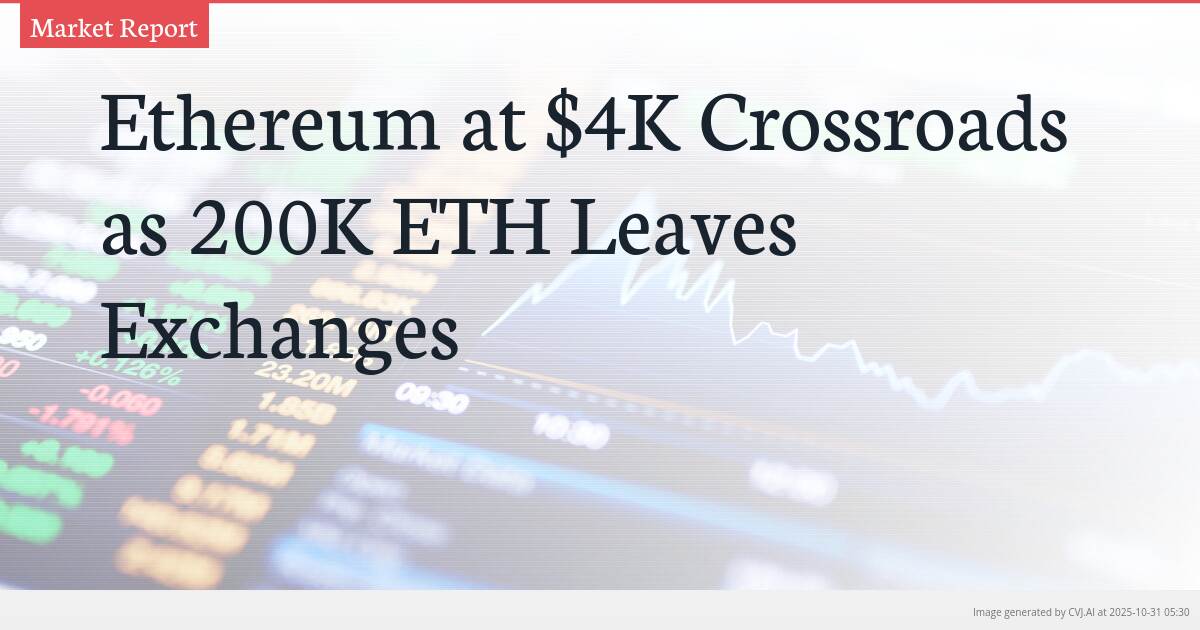This summary text is fully AI-generated and may therefore contain errors or be incomplete.
Introduction
Ethereum faces a critical juncture as it struggles to reclaim the $4,000 level while experiencing massive exchange withdrawals. Over 200,000 ETH worth $780 million moved to self-custody in 48 hours, signaling strong investor conviction despite price uncertainty. Analysts remain divided on whether this accumulation phase precedes a major bullish breakout or deeper correction.
Key Points
- Over 200,000 ETH ($780M) withdrawn from exchanges in 48 hours marks one of largest outflow spikes this quarter, signaling accumulation phase
- ETH trading below 50-day and 100-day moving averages with $3,800 as key support and $4,050-$4,150 as critical resistance zone
- Macro conditions improving with Fed rate cuts and quantitative tightening ending, historically benefiting risk assets like Ethereum
Massive Exchange Outflows Signal Investor Confidence
Ethereum is witnessing one of the most significant accumulation signals of the quarter, with more than 200,000 ETH—valued at approximately $780 million—withdrawn from exchanges within a 48-hour period. According to data from Santiment, this represents one of the largest short-term outflow spikes this quarter, indicating that investors are moving substantial amounts of Ethereum into self-custody rather than keeping them on trading platforms. Historically, such substantial exchange outflows have coincided with accumulation phases that often precede major market advances, suggesting growing confidence among long-term participants despite current price hesitation.
This divergence between price action and on-chain behavior underscores the current market debate surrounding Ethereum’s trajectory. While the price struggles to break above $4,000, the movement of such significant volumes off exchanges typically indicates that investors are positioning for medium-term gains rather than preparing for immediate selling. The $780 million worth of ETH moving into private wallets represents a strong vote of confidence in Ethereum’s fundamental prospects, even as technical indicators show weakness in the immediate price structure.
Technical Structure Shows Critical Support and Resistance Levels
Ethereum’s technical picture reveals a cryptocurrency caught in a tightening range after several failed attempts to reclaim bullish momentum. Currently trading near $3,905, ETH is holding above the critical $3,800 support level but remains capped below both the 50-day and 100-day moving averages, which are acting as dynamic resistance. The failure to sustain moves above the $4,200 resistance area earlier this month has led to a period of consolidation and reduced volatility, reflecting market indecision following recent macro-driven price swings.
For bullish momentum to re-emerge, analysts emphasize that Ethereum needs to achieve a daily close above the $4,050-$4,150 resistance zone. Such a breakthrough would signal a shift in market structure and potentially open a path toward retesting the $4,300-$4,500 range where supply pressure has consistently emerged in recent trading. On the downside, the $3,800 level represents the primary support to watch—a sustained break below this zone could expose ETH to lower levels near $3,500, particularly if broader market sentiment weakens. However, the 200-day moving average remains well below current price levels near $3,200, indicating that the long-term bullish structure remains intact despite short-term uncertainty.
Fundamental and Macro Tailwinds Support Medium-Term Outlook
Despite the current technical challenges, Ethereum continues to benefit from strong fundamental tailwinds that support its medium-term outlook. The network’s underlying strength is evidenced by increasing utility, expanding Layer-2 activity, and rising staking participation. These fundamental factors, combined with Ethereum’s established role as the primary settlement and liquidity hub for the altcoin ecosystem, position it to lead capital flows if market conditions turn decisively risk-on.
Macroeconomic conditions are also aligning in Ethereum’s favor, with the Federal Reserve cutting interest rates by 25 basis points and signaling the end of quantitative tightening. This shift toward monetary easing historically accelerates inflows into risk assets, including cryptocurrencies. As traditional markets anticipate a clearer pivot in monetary policy, investors may increasingly seek exposure to high-beta assets with strong structural narratives—a profile that Ethereum fits perfectly. The combination of improving global liquidity conditions and Ethereum’s fundamental strengths creates a compelling backdrop for potential upward movement once current technical resistance is overcome.
Analyst Divide Reflects Market Uncertainty at Critical Juncture
The current market environment has created a clear divide among analysts regarding Ethereum’s immediate direction. One camp points to Ethereum’s strong fundamentals—fueled by network activity, scaling advancements, and institutional traction—as reasons to remain bullish despite the price consolidation. They argue that the massive exchange outflows represent smart money positioning for the next leg higher, with the accumulation phase typically preceding significant price advances.
Conversely, other analysts warn of increasing downside pressure and weakening market structure that could lead to a deeper pullback. They note that ETH’s inability to reclaim key moving averages and break through the $4,000 psychological barrier suggests underlying weakness that could trigger further declines if support levels fail. This analytical split reflects the broader market uncertainty as Ethereum sits at a pivotal moment, with its ability to reclaim $4,000 likely determining whether bullish momentum re-emerges heading into November or whether further consolidation is necessary before the next significant move.
📎 Read the original article on newsbtc.com

